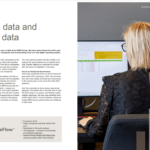Carbon footprint accounting? Here's what you need to know
Life cycle thinking in carbon footprint accounting
Activity-based approach and spend-based approach are two common Greenhouse Gas (GHG) accounting (commonly known as carbon footprint accounting) methods. While both are compatible with life cycle thinking, they differ greatly in the origins of inventory data and emission factors. Distinct origins and characteristics of the data used in these two approaches lead to significant differences in the data collection process, resulting in GHG inventories with varying levels of details, specificity, representativeness, and accuracy, and accordingly the applicability of the accounting results to decision making for corporates, consumers, and regulators.
Inventory: technical-physical data vs. financial data
The activity-based approach necessitates engineering process data of the processes managed by the reporting company as well as its suppliers and service providers, e.g. Bill of Materials. The collected data are in physical units such as kilograms and kWh. They are principally process-specific primary data supplemented by secondary market average data. The data collection process usually takes time and effort, however, it yields detailed, representative, and consistent results.
Differently, the spend-based approach requires exclusively financial data or purchases, and values are expressed in monetary units. Data from suppliers or service providers is not needed, thus reducing the time and resources for the inventory data curation process. However, financial data are subject to price fluctuations caused by varying exchange rates, changing market conditions, as well as other temporal and geographical factors. For instance, the same product bought in different purchasing conditions may have distinct GHG footprints, while the factual GHG emissions should remain the same. These complicate the spend-based approach and add great uncertainties not only to the financial inventories but also the GHG accounting results.
In this video we discuss and explain the differences between Spend based and Activity based approaches
Application: credible and consistent accounting vs. screening
The accounting results developed based on the activity-based approach provide a good representation of the reporting company’s specific value chain activities. The accounting allows the reporting companies to conduct baseline setting and identify key contributors and accordingly develop emission reduction plans. Given the consistency and credibility of the primary data and high-resolution emission factors, the obtained accounting results can be used to track progress of the reporting companies towards reduction targets.
The spend-based method can be a helpful tool for corporates to approximate organizational or product-level footprints during the initial screening phase of the climate combat journey. However, given the lack of specificity and consistency in the inventory data and low-resolution emission factors, GHG accounting based on the spend-based method is not recommended to be used for reporting or monitoring.
References
GHGP. (2011). Corporate Value Chain (Scope 3) Standard | Greenhouse Gas Protocol. https://ghgprotocol.org/standards/scope-3-standard
ISO. (2018). ISO 14064-1:2018 Greenhouse gases—Part 1: Specification with guidance at the organization level for quantification and reporting of greenhouse gas emissions and removals. ISO. https://www.iso.org/cms/render/live/en/sites/isoorg/contents/data/standard/06/64/66453.html








